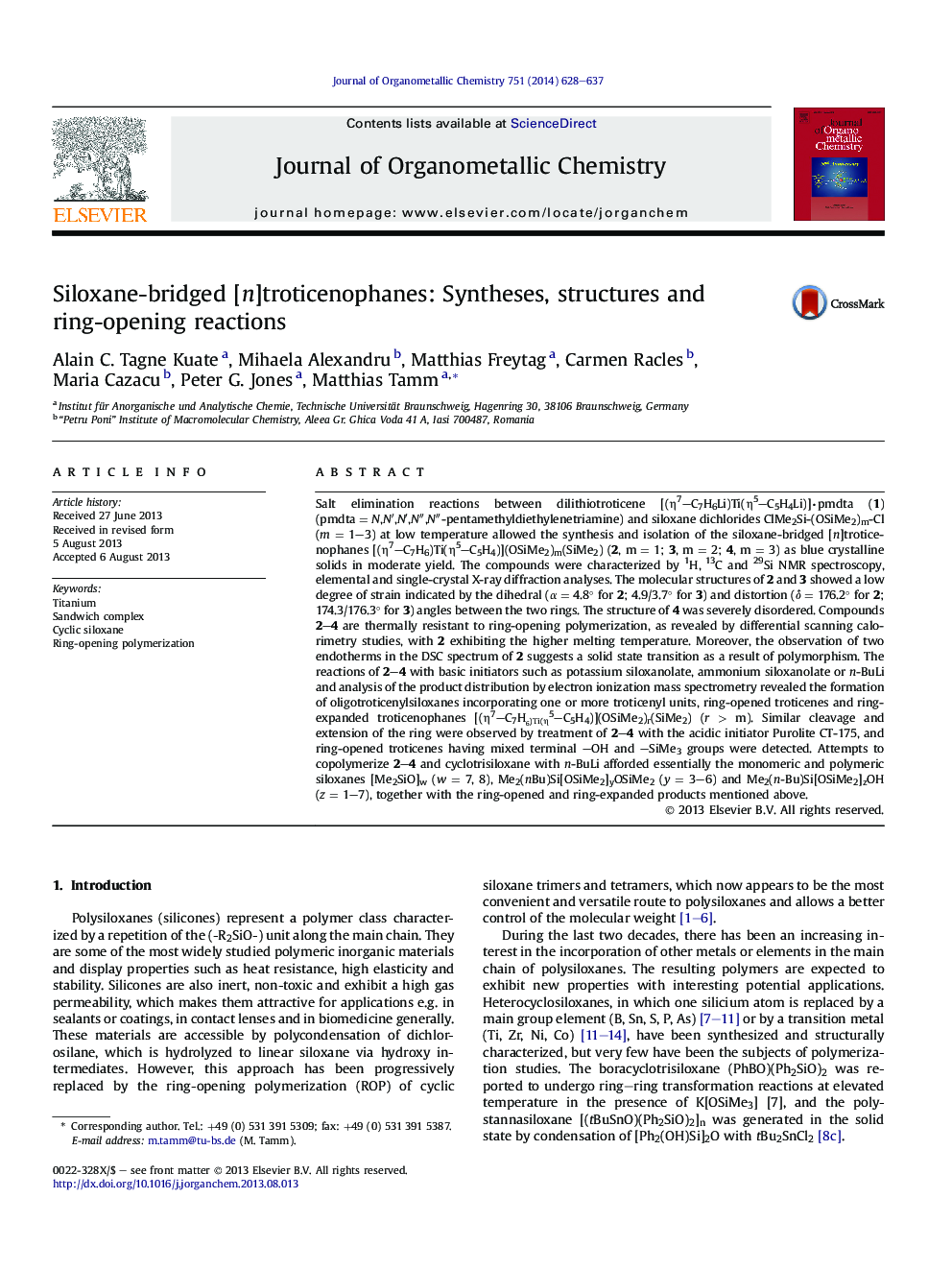| کد مقاله | کد نشریه | سال انتشار | مقاله انگلیسی | نسخه تمام متن |
|---|---|---|---|---|
| 1324322 | 1499889 | 2014 | 10 صفحه PDF | دانلود رایگان |
• Siloxane-bridged [n]troticenophanes were synthesized and fully characterized.
• Thermal behaviors were studied by DSC and resistance to ROP over 200 °C was observed.
• Redistribution reactions occurred in solution with detection of ring-opened products.
Salt elimination reactions between dilithiotroticene [(η7–C7H6Li)Ti(η5–C5H4Li)]∙pmdta (1) (pmdta = N,N′,N′,N″,N″-pentamethyldiethylenetriamine) and siloxane dichlorides ClMe2Si-(OSiMe2)m-Cl (m = 1–3) at low temperature allowed the synthesis and isolation of the siloxane-bridged [n]troticenophanes [(η7–C7H6)Ti(η5–C5H4)](OSiMe2)m(SiMe2) (2, m = 1; 3, m = 2; 4, m = 3) as blue crystalline solids in moderate yield. The compounds were characterized by 1H, 13C and 29Si NMR spectroscopy, elemental and single-crystal X-ray diffraction analyses. The molecular structures of 2 and 3 showed a low degree of strain indicated by the dihedral (α = 4.8° for 2; 4.9/3.7° for 3) and distortion (δ = 176.2° for 2; 174.3/176.3° for 3) angles between the two rings. The structure of 4 was severely disordered. Compounds 2–4 are thermally resistant to ring-opening polymerization, as revealed by differential scanning calorimetry studies, with 2 exhibiting the higher melting temperature. Moreover, the observation of two endotherms in the DSC spectrum of 2 suggests a solid state transition as a result of polymorphism. The reactions of 2–4 with basic initiators such as potassium siloxanolate, ammonium siloxanolate or n-BuLi and analysis of the product distribution by electron ionization mass spectrometry revealed the formation of oligotroticenylsiloxanes incorporating one or more troticenyl units, ring-opened troticenes and ring-expanded troticenophanes [(η7–C7H6)Ti(η5–C5H4)](OSiMe2)r(SiMe2) (r > m). Similar cleavage and extension of the ring were observed by treatment of 2–4 with the acidic initiator Purolite CT-175, and ring-opened troticenes having mixed terminal –OH and –SiMe3 groups were detected. Attempts to copolymerize 2–4 and cyclotrisiloxane with n-BuLi afforded essentially the monomeric and polymeric siloxanes [Me2SiO]w (w = 7, 8), Me2(nBu)Si[OSiMe2]yOSiMe2 (y = 3–6) and Me2(n-Bu)Si[OSiMe2]zOH (z = 1–7), together with the ring-opened and ring-expanded products mentioned above.
Siloxa[n]troticenophanes were prepared by metathesis of dilithiated troticene with 1,3-dichlorotetramethyl-, 1,5-dichlorohexamethyl-, 1,7-dichlorooctamethylsiloxane. The compounds exhibit thermal resistance to ring-opening polymerization (ROP) indicated by differential scanning calorimetry studies. However, investigations of ROP in the presence of potassium polysiloxanolate or n-butyllithium induce a redistribution reactions with formation of oligotroticenylsiloxanes incorporating two to four troticenyl units.Figure optionsDownload as PowerPoint slide
Journal: Journal of Organometallic Chemistry - Volume 751, 1 February 2014, Pages 628–637
